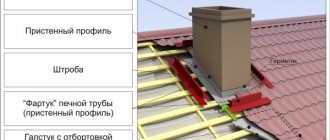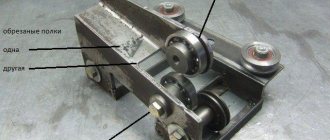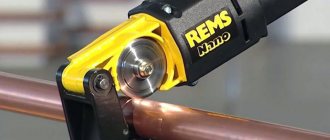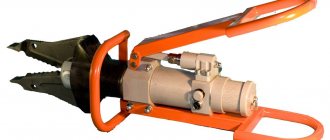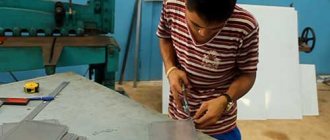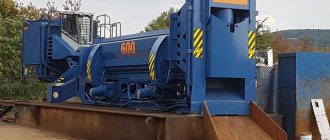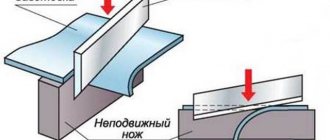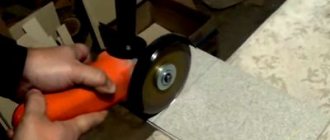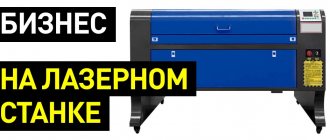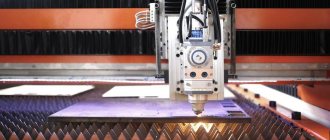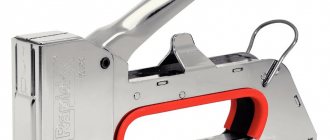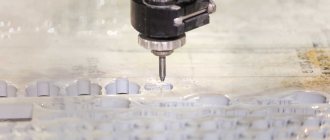How do you cut metal tiles?
Recommended tools for cutting profiled metal building materials:
- Nibblers for metal tiles
- Discs for cutting metal profiles
- Electric scissors
- Other special attachments
Typically, the manufacturer includes instructions with the material with recommended operating rules, which indicate tools that are prohibited from using. I'm interested in the question: is it possible to cut metal tiles with a grinder?
Manufacturing companies strictly prohibit, and in such cases product warranties are void!
The only option for using a grinder is a special disc for cutting metal tiles.
Factors why it is not recommended to use an angle grinder:
- When cutting metal, the abrasive wheel becomes very hot, which causes the original characteristics of the material and the protective surface to be destroyed (galvanization melts). During the work, sparks fall on areas of the material, destroying the coating, and they become centers of corrosion formation.
Is it possible to cut metal tiles with a grinder?
Manufacturers do not recommend cutting metal tiles using an angle grinder. Such actions can cause the following to appear on the sheets:
- torn edges, which after some time begin to oxidize and rust;
- corrosive changes after strong heating of the material.
You should not cut metal tiles when laying them on the roof with a grinder - this is too dangerous. In addition, as a result of the work, metal filings fly off, which remain on the surface of the profiled sheet and over time begin to rust and spoil the appearance of the roof. If, in the case of cutting with a grinder, the waterproofing layer is damaged, then all the moisture will penetrate into the roof, to the sheathing, which will lead to corrosion and damage.
Advice! If you need to cut metal tiles with a grinder, then you should add another 1-2 cm to the specific size, so that you can then cut it with metal scissors. The process is labor-intensive but effective.
Scissors carved
The main tool for cutting metal is special cutting shears. The tile profile often has turns of up to 90º; it is difficult to cut such a sheet with ordinary scissors, so it is recommended to use special scissors for cutting metal tiles.
Main advantages of the tool
- The scissors have small parameters and are equipped with comfortable handles.
- With this tool it is easy to cut the material along a curved line, and the metal does not heat up.
- The cutting shears maneuver perfectly when cutting material. The matrix holder with which the tool is equipped rotates. The longer it is, the more comfortable it is to work with the tool.
- The ability to adjust the angle of the handle allows you to prevent it from resting on the profile sheet being cut.
- This tool does not leave burrs.
- The duration of cutting profiled sheets with such a device is no longer than cutting metal tiles with an electric saw.
Design features of nibblers
Depending on the principle of operation and the type of cutting elements, electric shears are classified into several types: knife (slotted and sheet) and nibbler (notching). Their main difference lies in the internal and external design of the cutting materials, as well as the method of cutting metal products.
The main components of nibblers include:
- a punch (punch) - a movable element - is placed in a slider, which carries out reciprocal and translational movements supplied from the crank mechanism. The principle of operation of the tool is similar to the operation of a hole punch: cutting sheet metal occurs by making small grooves with scissors to fit the diameter of the punch. When processing thin materials, the shape of the punch should have a rounded appearance with a size of up to 3 mm. When cutting holes in massive elements, it is recommended to use square punch shapes. Rectangular punches produce punches with a rectangular profile and have high operational reliability. If necessary, they can be sharpened. Round punches produce horseshoe-shaped punches with directional edges and are well suited for curved cuts. Round punches cannot be re-sharpened.
The shape of the punch determines the shape of the resulting die cuts: rectangular - in the form of a rectangle, round - in the form of a horseshoe. The rectangular shape of the die-cuts is safer.
- the matrix is the stationary part of the device. It is installed in the matrix holder and rigidly attached to the casing of the entire mechanism. A moving punch is pulled or pressed through the matrix. The hole located in the matrix must have the same shape as the punch (rectangle or circle).
Nibblers can be used not only in sheet metal processing, but also in cutting steel products. For example, they can significantly help when cutting corrugated metal of any profile.
This tool is not inferior in speed to a regular angle grinder, is not capable of heating the cutting material and allows you to make any turns, including 90-degree ones. In addition, the scissors do not leave burrs on the edges, so there is no need for additional processing of the cut areas.
The advantages of nibblers are:
- compact dimensions;
- no damage to the polymer layers of metal tiles;
- cutting not only from the edge, but also from the middle;
- speed of cutting;
- stepless matrix permutation;
- performing a curved or straight cut;
- possibility of easy cleaning of chips formed during cutting;
- processing materials of various thicknesses due to the existence of types of tools of different power.
The main areas of use for nibblers include:
- roofing and facade works;
- metalwork in workshops;
- production of distribution cabinets;
- processing of metal products;
- recycling and dismantling.
Electric scissors with different attachments
Electric shears for cutting metal tiles are produced in three types: slotted, knife, and notching. Each type has its own distinctive characteristics
Slotted scissors
Electric shears for metal tiles effectively cope with any metal material and coating used for it. The cutting head of the electric shears allows you to make perfect cuts without distorting the tiles.
Advantages of using slotted electric shears:
- The tool is very convenient when performing figured cutting, and the sheet of material used is not subject to deformation. Scraps generated during the cutting process do not fall inside and are easily removed from the working area.
- Electric scissors were originally produced for ventilation. But, soon experienced roofers found use for them when arranging the roofs of buildings made of metal sheets.
The use of slotted shears in construction and repair work means high-quality cutting of sheet iron.
How can you cut metal tiles? Electric knife scissors are perfect for this job. The cutting component in the tool is two knife blades, one of which is movable, the other is not. When cutting, sheet iron is placed between them. After the work is completed, there is absolutely no waste left.
Disadvantages of such a tool
- Cutting can only be done from the edge of the material.
- It is not possible to make turns at a large angle when cutting.
Electric cutting shears can be used to cut profiled metal tiles and welded metal products.
How the tool works The operation of such a device is based on cutting out a small piece for each individual stroke with a punch. You can cut profiled sheets with this device from the edge or the middle (in this case, you just need to drill a small diameter hole using an electric drill).
Scissors of this type, due to the presence of an open cutting head, make precise cuts, and the cut material does not have distortions.
How to cut metal tiles?
Design features
In appearance, electric scissors are similar to a regular grinder.
The design of electric scissors includes the following elements:
- Housing with an electric motor inside. It has an elongated shape, thanks to which it fits well in the palm. On models with a heavy, powerful motor, an additional handle is placed on the body for convenience. Regardless of the type and cost of the tool, the body is always made of impact-resistant plastic.
- Multi-stage gearbox. Responsible for transforming the rotational movement of the motor into the reciprocating movement of the cutting head. Made of metal.
- Work node. Contains the knives or die and punch needed to cut metal.
- Metal shield. Protects the operator's hand from contact with the sharp edge of the workpiece.
- Electrical cord for supplying power to the instrument.
The way of working with electric scissors is no different from working with conventional ones. The operator smoothly guides the cutting head along the intended cutting line from the starting point to the ending point. The main rule of work: the speed of hand movement must correspond to the speed of cutting metal.
Expert opinion Kulikov Vladimir Sergeevich
The accuracy and precision of cutting on any electric scissors depends solely on the experience and skill of the operator.
Electric drill for cutting metal profiled sheets
One of the tools in demand by builders is a drill with a special attachment for cutting - a punch, a matrix. These elements are inserted under the material being cut. When the electric drill is started, the punch begins to move, cutting out a strip from above in the profiled sheet.
Before you start cutting entire metal profiled sheets, you should get your hands on the scraps.
Tool Specifications
- The nozzle provides a cutting width of 3 mm
- You can cut stainless steel sheets with a thickness of 0.8 mm
- Profiled sheets made of brass, sheet iron, galvanized steel can be cut if their thickness does not exceed 1.5 mm.
- Aluminum corrugated sheeting can have a thickness of 2 mm.
Special attachment “Cricket” for electric drill
The “Cricket” drill attachment for cutting metal tiles is a cutting shears that produces a fairly even cut. This mechanism can be used for flat, profiled metal sheets, polycarbonate, and plastic.
The maximum thickness of material that the cricket attachment can cut
- Stainless steel – 0.12 cm
- Sheet metal – 0.15 cm
- Aluminum sheet, copper - 0.2 cm
- Polycarbonate – 0.2 cm
The “Cricket” drill attachment allows you to work on vertical and horizontal surfaces and perform internal cuts. To perform a high-quality internal cut, a hole is pre-drilled in the workpiece.
Such a tool is simply irreplaceable when installing roofing structures made of metal tiles and corrugated sheets. It can be effectively used for artistic cutting. When using a cricket, the material is not deformed, and an even cut line is obtained.
Regardless of how metal tiles are cut, the cut areas are always treated with special anti-corrosion compounds or façade paint. It is also advisable to “hide” the cutting areas under the top sheets. It is recommended to plan the installation of the roof in such a way as to cut less building material.
Alternative tools for cutting metal tiles
To cut metal tiles, the sheet is laid on a flat horizontal surface. Beams of the same thickness are placed under it in several places. A line is drawn along the ruler with chalk or a felt-tip pen. When cutting, you must hold the sheet. To do this, you need to put a wide board on it and move along it, cutting and pressing at the same time. At the end of the work, you should sweep away debris and sawdust from the sheet. After cutting out the places of chips, cuts, and ends, they are treated with repair enamel polymer coatings to protect against corrosion.
A wonderful drill attachment for cutting metal tiles with the beautiful name “Cricket” easily copes with diagonal cutting of sheets of the most complex texture. Using fasteners, the nozzle can be set to the desired angle for ease of operation. This tool can easily cut steel sheets up to 0.8 mm thick. Compared to a circular saw and even a grinder, a drill with an attachment will cost less.
Electric cutting shears operate on the same principle. A rotating rod with Pobedit tips cuts the sheet not with the end, but with the side surface. These tools are good because they can cut out the most complex configurations from a metal sheet.
All of the above devices are good. But each of them is good in its own way. After comparing all the pros and cons, you can choose the most appropriate tool in this particular case.
Tools for cutting metal tiles
Before you begin roofing work, you need to know the basic recommendations regarding cutting roofing material . Some builders, not having complete information, use cutting tools that are strictly prohibited and incompatible with high-quality installation of metal tiles, so the following recommendations will not be superfluous.
What tools should you not use for cutting?
It's no secret that many people use a , seeing this as the fastest way to achieve the required sheet sizes. Although all roofing material manufacturers strongly recommend not using abrasive discs and inform about this in the instructions for use:
- firstly, the grinder destroys the polymer layer and contributes to the appearance of microcracks;
- secondly, manufacturers conduct a series of tests with the produced material and know exactly the weaknesses of their resource.
Despite all the controversy, developers continue to use the grinder, and the cut ends are covered with paints and varnishes. In this case, the question arises: why do double work and it is unlikely that such protective methods will completely restore the original qualities of the metal tile.
Manufacturers also do not recommend using tools in contact with which the material heats up.
Rules for cutting metal tiles
There are two optimal options for cutting roofing material:
- cutting by the manufacturer himself in accordance with the exact drawings provided;
- purchasing metal tiles of the required size for the roof.
If none of the conditions are met, you must adhere to the following recommendations.
- Electric nibblers are perfect for metal tiles. They can be used as a separate tool or as an attachment to an electric drill.
- As an alternative tool , use regular roofing shears for metal tiles.
- The use of an electric saw is compatible with roofing work only if a carbide blade with a fine pitch and a reverse angle is used.
- The use of a hacksaw for metal has a significant disadvantage - the tool cannot be used for cutting profiled sheets.
- A hand-held circular saw is used only with an aluminum circle. The material is reliable and durable and will not require replacement over a long period.
- If a grinder with an abrasive disc is the only option, it is important to ensure that sparks do not fall on the roofing material during the cutting process.
Whatever tool is used for metal tiles, it is advisable to treat the cut end sides with facade coatings. And during installation, the less protected side should be placed under the sheet.
Features of cutting with nibblers
- nibblers allow you to cut profiled metal sheets without much difficulty, even if the bend angles reach 90°;
- the handles of the scissors are made of soft material and do not rub your fingers when using the tool;
- The length of the matrix holder affects the maneuverability of the scissors. The longer the part, the easier and more convenient it is to cut. The matrix holder allows you to rotate the handles both perpendicularly and along the cutting direction;
- nibblers are most suitable for cutting metal tiles - during operation the edges are smooth without burrs;
- It is forbidden to cut several sheets at the same time - cutting should be done gradually. It is also necessary to ensure that the chips do not fall on other sheets of roofing material.
Types of nibblers
Nibblers allow you to cut profiled metal sheets without much difficulty.
For cutting steel sheets, you can use tools that differ in the type of drive and operating principle. Priorities are set based on your own skills, abilities, volume and specifics of the upcoming task.
When conducting private construction, you can use the following devices:
- Hand scissors. Their design is similar to office supplies. The differences lie in more powerful moving elements and the presence of a spring between the handles. The separation of metal occurs due to cutting under the influence of muscular force. To increase the force, attachments on the handles can be used. The edges are smooth and there is no waste. The product is simple, trouble-free, but its performance is extremely low. A good option for small-scale work, but not suitable for covering the roof of a house. Therefore, in the ranking of household tools, hand shears for corrugated sheets occupy the last place.
- Nibbler knives. The products belong to the category of semi-professional equipment. They are distinguished by a simple device, compactness and high performance. The principle of operation is to alternately cut out circles of metal enclosed in a matrix with a punch. The thickness of the processed sheet and the maneuverability of the device depend on the size of the matrix. The power of an electric cutter allows you to make straight and curved cuts not only on sheet metal, but also on thicker sheet metal, pipes, and other steel structures.
- Slotted cutters. Powerful and efficient professional cutting tool. The open head allows you to work with metal up to 5 mm thick, which is especially in demand in industrial construction. Cutting is carried out by two parallel blades, cutting out thin chips in the form of a continuous strip 3 mm wide. The edges are perfectly smooth without any curvature. A powerful motor ensures continuous movement of the device on flat and corrugated surfaces. The device is the most productive, but costs much more than its analogues.
The best option for a private developer is die-cutting devices. They have the most optimal price-quality ratio with a sufficient level of reliability and durability.
Electric shears for metal tiles
There are three types of electric shears:
- die- cutting They allow cutting not only metal tiles of various profiles, but also metal elements from several sheets welded together. The principle of operation is that the punch cuts out a certain piece of material with each stroke;
- knife _ The cutting part of the tool consists of a movable upper blade and a fixed lower one. The peculiarity of using electric knife scissors is that there is practically no waste left during the work. But at the same time, the tool does not allow making sharp turns;
- splined _ These electric shears allow you to cut sheets of various materials. During cutting, the stroke is neat and as precise as possible, and no distortions are formed. The sheet does not deform, and the chips lie smoothly on the surface of the roofing material, which makes it easy to remove debris at the end of the work.
Hacksaw or electric jigsaw
The cheapest and most time-tested tool is a hand saw for metal. Does not require special skills and is available in almost every home. But at the same time, the saw does not allow performing figured cutting; for this it is necessary to resort to improved tools.
An electric jigsaw makes no less quality moves than cutting scissors, but it will take more time. A jigsaw with special attachments allows you to cut any profiled metal sheets.
It is interesting to know that the first mechanical metal shears were designed for installing ventilation ducts and systems. Over time, the tool has been radically improved and is now used for roofing work.
How to cut metal tiles without damaging the material?
The use of metal tiles is considered a practical, durable and aesthetic way to cover the roof of a modern townhouse, country house or country cottage, one of the advantages of which is the ease of installation yourself. However, the manufacturers of this roofing material never tire of reminding that it will last a long time and reliably only if the rules of processing and installation are followed. Therefore, inexperienced craftsmen who take on this work have a question about how to cut metal tiles so as not to damage them. In this article we will talk about the tools that are recommended to be used for processing metal profiles.
Repair
Over time, scissors become unusable, and the main problem is their dullness.
Sharpening on a whetstone.
- If you want to sharpen your scissors, it's best to take them apart and use both sides as separate "knives." Then sharpening the entire edge will be much easier. In addition, you will protect yourself by not cutting yourself with another blade while sharpening.
- It is necessary to choose the right sharpening stone. If you only need to sharpen the tool a little, you can use a fine stone (1000 grit or higher). If the scissors are dull enough, you should first repair the edge with a coarser sharpening stone. Consider a grit of 100 to 400. Considering that almost all scissors are made of stainless steel, you can use any type of abrasive.
- To get quick results, you can choose a diamond stone. Its advantage is that it will last a long time. However, if you want more accurate results, you can use ceramic or aluminum oxide.
- Next you need to sharpen the inside of the first blade. Frequent use of scissors, during which both blades move against each other, can eventually lead to wear and tear. This is what needs to be restored first. Plus, this also removes any potential rust.
- After adding water to the whetstone, place the scissor blade on its surface. The blade is moved from the place where it intersects the handle to the tip. Use the full length of the stone and do not apply too much pressure. Repeat this until all the rust is removed. You can also use a marker to mark the entire blade. And once you remove all the markings, the blade is completely ready.
- Next are the edges. The advantage of sharpening scissors over a knife is that the blade is relatively wide and easily visible. As a result, the correct sharpening angle seems to have already been selected. You place the blade on the whetstone at an angle to ensure that the entire edge is in contact with the stone. Now you need to make the same movement from the center to the tip, using the entire sharpening surface.
- Repeat the process with the other half of the scissors. Place both pieces together and make a couple of cutting motions.
To save money, professionals sometimes make their own scissors. The main thing is that they are made of a super-strong alloy and according to the appropriate drawings. For example, bearings are used to produce roller shears.
For more information about metal scissors, see the following video.
Features of the material
Metal tiles are profiled sheets of galvanized steel, onto which a polymer coating is applied that protects the material from rust and mechanical damage. The polymers used for the production of roofing (pural, plastisol, polyester) have a fairly low melting point, so it is not recommended to use an abrasive tool for cutting metal tiles. The use of such devices causes the following consequences:
- When the grinding disc operates at high speed, the polymer coating along the edges of the cut melts, resulting in the formation of “bald spots” of unprotected metal on the surface of the metal tile.
- When cutting metal tiles with an abrasive tool at high speeds, the edges of the cut are heated to a significant temperature, due to which the properties of the steel change for the worse and the zinc layer melts.
- After 1-2 years of operation, places where the polymer and zinc layers are damaged due to the use of an abrasive cutting tool become centers of corrosion, irreversibly destroying the structure of the material.
Note! It is allowed to process, cut and install metal tiles only using cold methods, that is, you cannot use welding or a grinder. It is better to order sheets of the required size than to cut metal tiles with abrasive tools, since after their use the factory warranty on the roofing is removed.
Features of cutting metal tiles
Metal tiles on the construction market are presented as a profiled sheet of galvanized steel. It is distinguished by the presence of a polymer coating on the surface, which prevents rust and mechanical damage. Among the working properties of the polymers used to make this roofing material (pural, polyester, plastisol), there is a fairly low level of melting temperature, which does not limit the choice of tools for cutting profiled sheets. If you use abrasive devices, the following negative phenomena are observed:
- The appearance of “bald spots” of unprotected metal on the surface of a metal tile as a result of the operation of a grinding disc at high speeds.
- Melting of the zinc layer due to the use of an abrasive tool at high speeds.
- Formation of corrosion spots a couple of years after damage to the polymer and zinc layer with an abrasive tool. These lesions significantly destroy the structure of the roofing material.
Important!
To process or cut sheets of metal tiles, it is effective to use only cold methods. The best option is to order roofing material already cut to specific sizes, since after using abrasive tools, the manufacturer’s warranty becomes invalid. If you follow the basic recommendations regarding cutting and installation, a roof made of metal tile sheets not only has a beautiful appearance, but is also reliable and durable. Profiled galvanized sheets can last almost 50 years, only after 10-20 years they need to be repaired, tinted or replaced if necessary. They are easy to install and are relatively lightweight, which allows them to be used on buildings with weak foundations and insufficient load-bearing capacity of the rafter system. A roof made of metal tile sheets is not subject to deformation due to temperature changes or excessive humidity. In addition, such a roof is capable of self-cleaning from snowdrifts.
Valid Methods
Manufacturers of metal tiles cut the material into sheets of arbitrary length in the range of 0.4-8 m, so it is more convenient to order material that matches the size of the roof slope. This will save the developer money, due to the absence of horizontal overlaps, and will also reduce work time, since sawing sheets with your own hands is difficult and time-consuming. Inexperienced builders often do not know how to cut metal tiles due to their wavy profile. The following tools are suitable for this:
- Hacksaw for metal. This is the most affordable tool with which you can cut sheets of metal profiles. However, this will require a special workbench. Additionally, a hacksaw is only suitable for making straight cuts.
- Nibblers. Specialty nibblers designed for cutting metal can be a separate tool or an attachment for an electric drill. Using such scissors can significantly simplify and speed up the cutting process. If there are no alternatives, manual roofing shears for metal tiles are also suitable.
Important! The edges remaining after sawing sheets of metal profiles without a polymer coating become vulnerable to corrosion, so they must be coated with protective varnish or paint. And the material is laid so that the cut is under the overlap of the top sheet and does not come into contact with moisture.
Types of scissors
Metal tiles have a complex surface topography, which makes cutting sheets with ordinary metal scissors extremely problematic; you have to use nibblers. They have a universal purpose and cope equally well with making straight or curved cuts. The maneuverability of the tool depends on the length of the matrix holder. Electric scissors for cutting metal tiles come in 3 types:
- Nibblers. The mechanism of action of this tool is simple - each stroke of the punch cuts out a piece in a sheet of metal. They are used for processing metal tiles, corrugated sheets, pipes, and welded structures. Nibblers can cut a sheet both from the edge to the middle, and in the opposite direction, if you make a hole at the starting point with a drill.
Experienced craftsmen recommend that before cutting metal tiles, practice using the remaining material to make an accurate and even cut. In addition, you should only use tools recommended by the manufacturer.
Types of tools for cutting metal tiles
Cutting metal tiles is difficult because its surface is not horizontally flat, but wavy. At the industrial level, expensive high-performance tools are used. But how can the average builder cut metal tiles if he decides, for example, to repair the roof at his dacha?
There are several ways and tools to do this job:
- cutting with metal scissors;
- cutting with a jigsaw;
- using a circular saw;
- Bulgarian;
- drill with attachment;
- electric cutting shears.
Let's look at all the options presented in more detail, starting with the most popular:
Metal scissors
Cutting metal tiles with scissors
If the construction site is small and there is not much to be cut, you can use ordinary and familiar metal scissors. But at the same time, you should prepare in advance for the fact that the work will be labor-intensive.
Scissors work well with thin sheets, but the craftsman has to make a lot of effort. The hand gets tired quickly. To avoid injury, you have to bend one edge that has already been cut off upward. In addition, during the “wave”, the scissors crush and deform the metal.
The advantage of using such a tool is the already stated simplicity, low cost and a good unburnt end. They are convenient and safe for cutting metal directly on the roof.
Jigsaw
Working with an electric jigsaw on metal is only slightly easier than using scissors. It does not take the edges well and bends them, so it is recommended to make a small preliminary cut with scissors.
In places where the sheet makes a wave, the jigsaw, due to the reciprocating movements, slightly straightens the irregularities, especially on short workpieces, so after cutting, the length of the edge may increase, which interferes with the correct assembly of the roof, especially the hip roof.
Before cutting metal tiles with a jigsaw, you need to select a file that is long enough to accommodate the wave height. If its movements are limited to a range of 2 cm, and the height of the wave on the sheet is 4-6 cm, then the length of the file, taking into account the fastening, should be at least 10-11 cm.
In order not to damage the surface of the sheet or tear off the paint in the cut areas, we recommend purchasing electric jigsaws with rubberized guides. You can glue the soft strips yourself by cutting them out of a regular medical adhesive plaster.
A circular saw
A hand-held circular saw is the best tool for cutting metal tiles, according to many builders. The work is completed literally in seconds, the edges of the metal are smooth and do not overheat. The best result occurs when a universal Pobedit disc is used for cutting metal tiles.
These tools always live up to expectations, but each of them has its own disadvantages and advantages:
Comparison table of tools for cutting metal tiles
It is clear that, despite all the excellent performance, a circular saw, especially with a Pobedit blade, is not affordable for all craftsmen. For a simple small gable roof, diagonal cuts are not required, which means you can get by with well-sharpened metal scissors.
